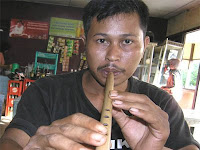With his sturdy build and skin darkened by hours toiling under the sun, Muda Balia looks more like a farmer than a storyteller. Muda, 29, who comes from Senebok Alur Buloh village in South Aceh, did work as a farmer for a while after returning to his village to take care of his sick mother.
"My skin beca
 me dark because it was too frequently exposed to sunshine when I was farming back home," he said.
me dark because it was too frequently exposed to sunshine when I was farming back home," he said. When Muda met with The Jakarta Post, he had just arrived in Banda Aceh after traveling from his village by van.
"I've been invited to perform my traditional Acehnese storytelling show in Kalimantan," he said.
With only a few hundred thousand rupiah on him, Muda left his village, his beloved mother and his wife, who was 5 months pregnant, to take his show on the road.
But despite the invitation to perform in Kalimantan, Muda says there is little demand for his storytelling skills.
"Today, traditional storytelling is no longer popular, as modern society is filled with technology and entertainment," Muda told the Post.
"In the past, communities used the art of storytelling as the most effective medium of communication to convey something, ranging from a religious message to just entertainment."
Even during colonial times, he added, the Dutch could not quell the rebellion by the Acehnese, who were inspired by the story of Perang Sabi as told by the Acehnese storytellers.
During the time of the military operation in Aceh between 1989 and 1998, which was carried out by the Indonesian government to quash the Free Aceh Movement, elders in the region would secretly recount to local youths the story of Perang Sabi to arouse their courage so that they would be ready to die fighting.
The art of storytelling is an integral part of everyday life -- religious, social and cultural -- for the Acehnese.
The Acehnese have their own rich oral tradition, and have several names for the art of storytelling, including peugahaba, meuhaba, pohaba, pakaba, poh cakra, poh tŠm and cang panah.
The art of storytelling in Aceh has had its ups and downs over the years. Muda said the art lost its popularity in Aceh after the political turbulence of 1965, when members of the Indonesian Communist Party were massacred.
"At that time, the rulers saw the potential danger brought about by the art of storytelling in Aceh, so the government kidnapped all storytellers and killed them," he said.
As a result, storytelling, particularly the traditional style, virtually disappeared as few storytellers remained to pass on the skill.
"Now there are perhaps no more than 10 storytellers in Aceh, most of them elderly," Muda said.
As one of Aceh's few remaining traditional storytellers, Muda is very concerned about the preservation and development of this art.
"If the government does not immediately take action, the young generation in Aceh will never know that Aceh used to have excellent literary artists," he said.
"If the oral tradition is lost, it is the Aceh people themselves that will miss out."
At present, there is not a single written literary work that has recorded the tales that traditional storytellers narrate. Generally, these tales are learned by heart.
"If the storyteller dies, these stories will also die and be buried with them."
Muda said his greatest wish was to preserve Acehnese traditional stories by producing a book of all the stories he knows by heart.
However, he said, financial difficulties meant he had to concentrate on being a farmer first to support his family.
"It will take a lot of time and money to be able to write down all the stories that I know by heart," he said.
"I have opted to feed my family first. If our economic situation improves, hopefully before I die, I can realize this dream."
Muda said he was inspired by the Acehnese traditional storyteller Matlapee, who was thought to have had a mental disorder and was said to be mad.
Matlapee was rumored to have slept for seven days and nights and upon waking told his mother a spirit had come to him and told him long-forgotten stories.
Matlapee later passed on these stories to four of his disciples: Zulkifli, Siaron, Dawod Baneng and Tgk Adnan.
Acehnese traditional storytelling developed rapidly in the western and southern coastal areas. Tgk Adnan spread the art of storytelling along the eastern coastal area on his travels selling medicine.
"Tgk. Adnan used this art of storytelling as a medium of communication with his buyers," Muda said.
These four disciples of Matlapee have since died -- and many of the stories they told have died with them.
Muda was one of Zulkifli's students.
Traditional props, such as a sword, bangsi (flute), pillow and a mat, are used to tell a story.
"It all depends on the story being told," Muda said.
"I cling to the principle of the traditional art of story telling, whereas other remaining storytellers have opted for more contemporary and contextual forms of storytelling in keeping with the times."
Tidak ada komentar:
Posting Komentar